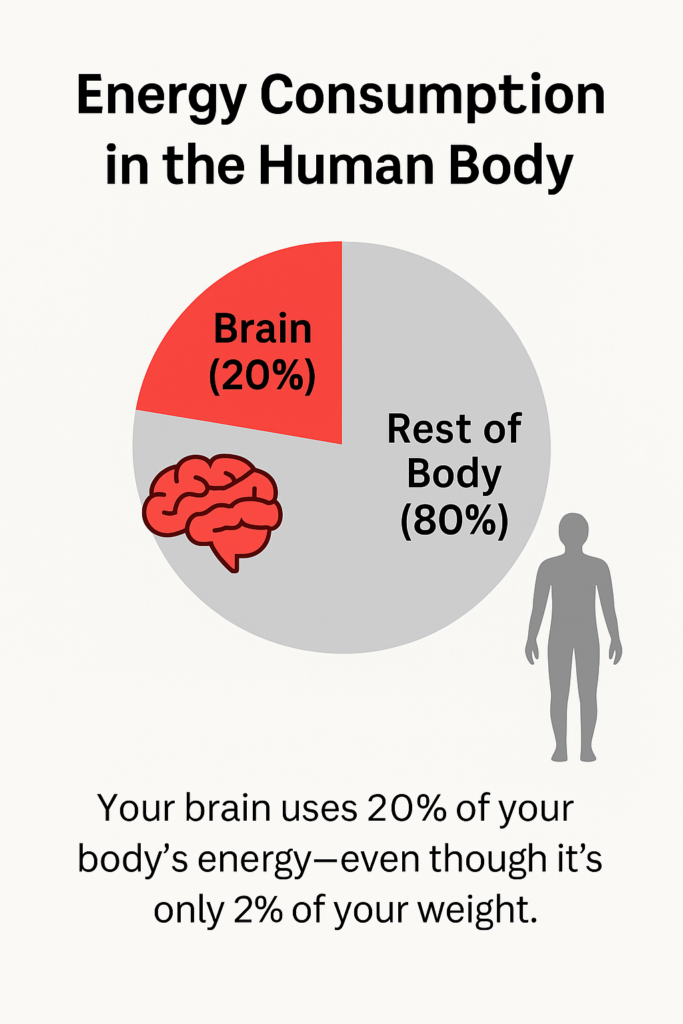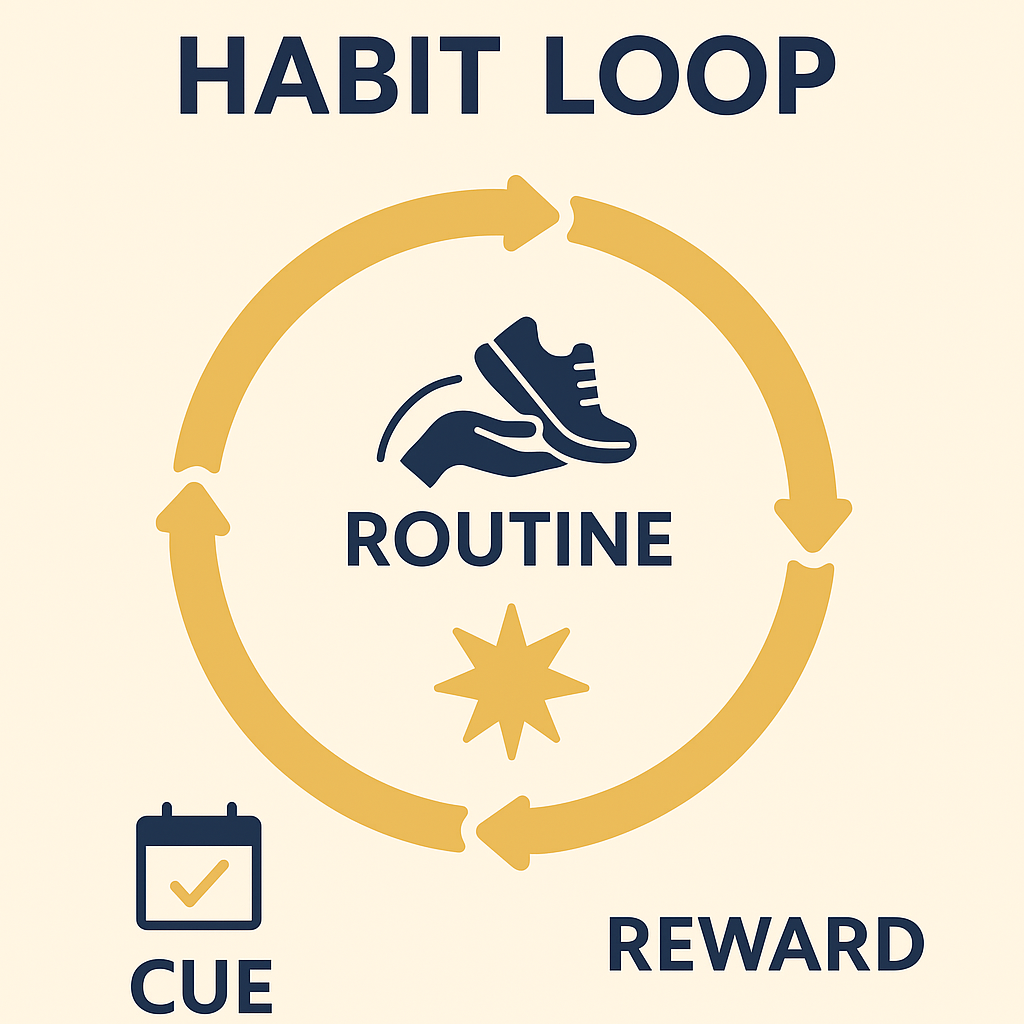
SERIES 1: “The Human Code: Why We Are the Way We Are”
Why We Default to Autopilot, Routines, and Habits — and How They Shape Our Identity
Have you ever arrived at your destination with no memory of the drive there? Or found yourself reaching for your phone dozens of times a day without consciously deciding to do so? These moments reveal one of the brain’s most powerful yet overlooked features: its tendency to operate on brain autopilot—the default mode that conserves mental energy while running our daily lives.
While we often pride ourselves on our thoughtful decision-making, the surprising truth is that approximately 40% of our daily actions occur automatically without conscious deliberation. This isn’t a flaw in our cognitive design—it’s a feature that evolved to help us survive and thrive.
In this fourth article of our series exploring the mind’s hidden mechanisms, we’ll examine why our brains love to default to autopilot, how this shapes our behaviors and identity, and what we can do to take back control when necessary. This builds upon concepts from our previous articles on cognitive biases, decision-making, and memory formation.

The Brain’s Energy Crisis
📖 Learn More: Scientific Reports – The Brain Selectively Allocates Energy | SHA Magazine – Living on Autopilot
Despite making up only about 2% of your body weight, your brain consumes a staggering 20% of your body’s energy. This metabolic demand creates a constant pressure to optimize neural efficiency. As Nobel Prize winner Daniel Kahneman noted, “The brain is an energy-saving machine that likes automatisms and relies on experience and intuition.”

This energy constraint explains why your brain is constantly looking for shortcuts. Every conscious decision, every moment of focused attention, and every new skill being learned demands significant energy. By automating routine tasks through habits, your brain can dramatically reduce its workload.
🔹 Example: Think about learning to drive. Initially, every action required intense concentration—checking mirrors, applying the right pressure to pedals, signaling turns. Now, experienced drivers can navigate familiar routes while carrying on conversations or thinking about their day, barely aware of the complex motor sequences their bodies are performing.

The Neuroscience of Autopilot
The shift from conscious effort to automatic behavior involves a fascinating neural transition from the energy-intensive prefrontal cortex (responsible for executive functions and decision-making) to the more efficient basal ganglia (involved in routine behaviors and habit formation).
How Habits Form in the Brain
1️⃣ Initial Learning – Prefrontal Cortex Engagement
When we perform a new action, the prefrontal cortex—our brain’s CEO—is heavily involved. This region helps us pay attention to details, make decisions, and coordinate our efforts. This process is energy-intensive and requires conscious focus.
2️⃣ The Habit Loop Formation
With repetition, our brains begin forming a “habit loop” consisting of:
- Cue: The trigger that initiates the behavior (like seeing your running shoes by the door)
- Routine: The behavior itself (going for a morning run)
- Reward: The positive reinforcement (endorphin release, sense of accomplishment)

Each successful completion of this loop releases dopamine, a neurotransmitter that strengthens the neural pathway and makes the behavior more likely to occur again.
3️⃣ Neural Shift to the Basal Ganglia
As Professor Gerhard Roth explains, “When we learn something for the very first time, this is controlled by our cerebral cortex. Once we’ve repeated this action multiple times, it becomes routine. The relevant information slips into our basal ganglia, deep inside the brain. Here it is stored as fixed processes that can no longer be easily deleted.”
This shift to the basal ganglia allows behaviors to become automatic, requiring minimal conscious input and dramatically reducing cognitive load.
4️⃣ Automaticity Achievement
Eventually, the habit becomes so ingrained that it triggers automatically in response to the cue, without conscious thought. Your brain essentially switches to “screen saver mode,” allowing you to perform the action while freeing up mental resources for other tasks.

🧠 Key Takeaway: Habit formation is not just about willpower—it’s a physical rewiring of your brain that makes behaviors increasingly automatic and energy-efficient. This explains why habits are simultaneously so powerful and so difficult to change.
The Evolutionary Advantage of Autopilot
From an evolutionary perspective, our brain’s preference for routines and habits makes perfect biological sense:
Energy Conservation for Survival
For our ancestors, energy conservation wasn’t just about efficiency—it was about survival. In environments where food was scarce and threats were constant, the ability to perform necessary tasks with minimal cognitive effort provided a crucial advantage.
Social Conformity and Rejection Avoidance
Our evolutionary success has always depended on group acceptance. Being rejected from the tribe could mean losing access to resources, protection, and reproductive opportunities—essentially a death sentence in prehistoric environments.
This created a powerful evolutionary pressure to avoid behaviors that might lead to social rejection. By developing consistent routines that aligned with tribal expectations, our ancestors could minimize the risk of standing out in dangerous ways.

🔹 Example: Consider how powerfully most people feel the sting of rejection even today. Studies show that social rejection activates the same brain regions as physical pain. This isn’t coincidental—it’s an evolutionary alarm system designed to keep us safely within the group’s expectations and routines.
How Autopilot Shapes Our Identity
Our habitual behaviors don’t just reflect who we are—they actively create our sense of self. Consider the following ways autopilot shapes identity:
The Routines That Define Us
- Communication Habits: Your conversational patterns, vocabulary, and listening behaviors.
- Time Management: How you prioritize activities and navigate your daily schedule.
- Problem-Solving Approaches: Your default strategies when facing challenges.
- Emotional Responses: Your typical reactions to stress, joy, disappointment, or conflict.
These routinized behaviors form the foundation of how others perceive you and how you understand yourself. As William James, the father of American psychology, famously said: “We are what we repeatedly do.”
The Invisible Script
Many of our most important life choices—from career paths to relationship patterns—are influenced by automatic thinking that runs beneath our conscious awareness. These “invisible scripts” often come from:
- Cultural Programming: Societal expectations about success, relationships, and life milestones.
- Family Patterns: Behaviors modeled by parents and reinforced throughout childhood.
- Past Experiences: Automatic responses developed from previous successes or traumas.
When left unexamined, these scripts can lead us to live lives based more on autopilot than authentic choice.
A Day on Brain Autopilot: Sarah’s Story
🔹 Case Study: Sarah, a 34-year-old marketing executive, decided to track how much of her day was spent on brain autopilot. What she discovered shocked her:
“Monday morning, I documented my routine minute by minute. I woke to my alarm, silenced it, checked emails, showered, dressed, made coffee, fed the cat, grabbed my keys, and drove to work—all without making a single conscious decision. I was halfway through my commute when I realized I couldn’t remember if I’d locked the front door or even what I was wearing. Looking down at my blue blouse, I had zero recollection of choosing it. By tracking my day, I discovered nearly 70% of my actions were completely automatic. What scared me wasn’t just how much I operated on autopilot, but how this mental efficiency was robbing me of actually experiencing my life.”

Sarah’s experience highlights how brain autopilot, while neurologically efficient, can disconnect us from our lived experience and diminish our sense of agency.
The Dark Side of Autopilot
While our brain’s energy-saving mechanisms offer tremendous benefits, they come with significant costs:
Reduced Autobiographical Memory
Research suggests that living on autopilot can significantly reduce the formation of autobiographical memories. When we perform actions without conscious engagement, the brain doesn’t fully encode these experiences, leading to a sense of life passing by in a blur.

🔹 Example: Have you ever reached the end of a workday and struggled to remember what you actually did? Or finished a meal without recalling the taste? These are symptoms of autopilot living.
Resistance to Change
The fixed processes stored in the basal ganglia are notoriously difficult to modify. As Professor Roth notes, “This is why it’s extremely difficult to try and replace an old habit with a new one.”
This explains why, despite our best intentions, we often find ourselves reverting to established patterns even when we know they don’t serve us well.
Mindless Consumption
When operating on autopilot, we become more susceptible to marketing influences and environmental cues that trigger consumption behaviors. From mindless snacking to impulsive purchases, these unconscious actions can undermine our wellbeing and financial health.

Decreased Life Satisfaction
Perhaps most significantly, excessive autopilot living can lead to a profound disconnection from present experiences. The richness of life—its sensory details, emotional nuances, and meaningful moments—requires conscious attention to fully appreciate.
Breaking Free from Brain Autopilot: The Science of Intentional Living
Understanding the brain’s energy-saving tendencies doesn’t mean we’re doomed to live on autopilot. By applying scientific insights, we can harness the power of habits while maintaining conscious control over our lives.

Strategies for Building Better Habits
📖 Learn More: Forbes – Mastering Autopilot | The Neuroscience of Habit Formation
✅ Start Small – Begin with manageable changes to avoid overwhelming the brain’s resistance to new patterns. Focus on one habit at a time.
✅ Design Your Environment – Modify your surroundings to reduce friction for desired behaviors and create barriers for unwanted ones.
✅ Use Habit Stacking – Attach new habits to existing automatic behaviors. For example, “After I brush my teeth, I will meditate for two minutes.”
✅ Leverage the Reward System – Ensure new habits provide immediate positive reinforcement to strengthen neural pathways.
✅ Practice Consistency – Regular repetition is crucial for transferring responsibility from the prefrontal cortex to the basal ganglia.
✅ Prepare for Obstacles – Anticipate challenges and create specific if-then plans for maintaining habits when disruptions occur.

Cultivating Mindful Awareness
📖 Learn More: The Neuroscience of Living in the Present Moment
✅ Daily Reflection – Set aside time to journal about moments when you operated on autopilot and identify opportunities for greater presence.
✅ Pattern Interruption – Introduce novel elements into routine activities to heighten awareness, like using your non-dominant hand or taking a different route home.
✅ Sensory Engagement – Deliberately focus on sensory details during everyday activities—the taste of your food, the feeling of water on your skin, the sounds in your environment.
✅ Mindfulness Practice – Regular meditation strengthens the brain’s capacity to maintain present-moment awareness, even during routine activities.

Overcoming the Fear of Rejection
Our autopilot behaviors are often reinforced by an evolutionary fear of rejection. By building rejection resilience, we gain the freedom to consciously choose our actions rather than defaulting to socially safe patterns.
✅ Set “Rejection Goals” – Deliberately seek situations where rejection is possible to desensitize yourself to its impact.
✅ Reframe Rejection – View rejection as redirection rather than failure, and as information rather than judgment.
✅ Analyze Without Personalizing – When rejection occurs, look for situational factors and learning opportunities rather than assuming personal inadequacy.
✅ Build a Support System – Cultivate relationships that provide security and encouragement for taking risks and breaking automatic patterns.
The Balanced Path Forward: Managing Brain Autopilot
The goal isn’t to eliminate brain autopilot entirely—that would be neurologically impossible and practically exhausting. Instead, the aim is to develop a harmonious relationship between your brain’s energy-saving mechanisms and your conscious intentions.
When to Embrace Autopilot
- Routine Tasks: Let habits handle recurring activities that don’t require creative thought.
- Skill Execution: Trust the automaticity you’ve developed in areas of expertise.
- Emergency Responses: Allow trained automatic reactions to take over in high-pressure situations.
When to Override Autopilot
- Decision Points: Pause at life’s crossroads to ensure choices align with authentic values.
- Relationship Interactions: Bring conscious attention to how you connect with others.
- Learning Opportunities: Engage fully when acquiring new knowledge or skills.
- Meaningful Experiences: Be present for the moments that matter most.

Final Thoughts: Mastering Your Brain Autopilot
Your brain’s energy-saving mode is neither villain nor hero—it’s a sophisticated evolutionary adaptation that can either limit or expand your life experience depending on how consciously you engage with it.
By understanding the neurological basis of autopilot, you gain the power to harness its efficiency while remaining the author of your own story. This balance allows you to conserve mental energy where appropriate while investing your conscious attention in the experiences and choices that truly matter.
The routines and habits that run beneath your awareness aren’t just behaviors—they’re the building blocks of your identity. By bringing them into consciousness, you reclaim the ability to shape not just what you do, but who you become.

❓ Frequently Asked Questions
Q: What is brain autopilot?
A: Brain autopilot refers to the unconscious routines and habits your brain performs automatically to save energy and mental effort. It’s a neurological mechanism that shifts control from the prefrontal cortex to the basal ganglia, allowing you to perform routine tasks without conscious deliberation. Approximately 40% of your daily actions occur in this energy-saving mode.
Q: Is brain autopilot bad?
A: Brain autopilot isn’t inherently bad—it’s an essential evolutionary adaptation that helps with efficiency and energy conservation. However, excessive reliance on autopilot can reduce mindfulness, decrease autobiographical memory formation, and diminish overall life satisfaction. The key is finding balance between automatic efficiency and conscious engagement.
Q: How can I break out of autopilot mode?
A: You can break out of excessive autopilot mode using evidence-based strategies like habit stacking (attaching new behaviors to existing routines), environmental design (modifying your surroundings to prompt conscious choices), pattern interruption (introducing novelty into routines), mindful reflection (journaling about automatic behaviors), and consistent practice of present-moment awareness techniques. Start small with one area of your life rather than attempting total transformation.
Q: How long does it take to form a new habit?
A: While popular wisdom suggests 21 days, research indicates that habit formation typically takes anywhere from 18 to 254 days, with an average of 66 days for a behavior to become automatic. The time varies based on habit complexity, individual differences, consistency of practice, and the presence of effective rewards. Simple habits form faster than complex ones, and consistency matters more than perfection.
Q: Can I change habits that are stored in my basal ganglia?
A: Yes, you can change deeply ingrained habits stored in the basal ganglia, but it requires consistent effort and the right approach. Rather than trying to delete old habits (which is neurologically difficult), focus on replacing them with new behaviors that serve the same cue and provide similar rewards. With repetition, these new neural pathways can become stronger than the old ones, effectively overriding the automatic response.
🔗 Related Articles in This Series:
🧠 Coming Up Next:
Part 5: The Dopamine Trap
Why chasing rewards makes us miserable—and how our brain tricks us into craving, not having.
We’ll dive deep into the brain’s reward system, explore the difference between motivation and satisfaction, and uncover how dopamine drives habits, desire, and even self-sabotage.
🔔 Follow Fat Ginseng to stay updated and get more insights into psychology, behavior, and the hidden mechanics of being human.


